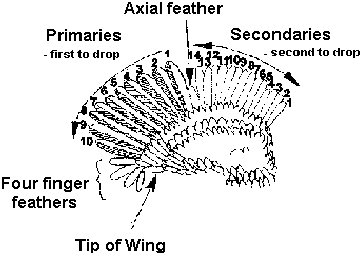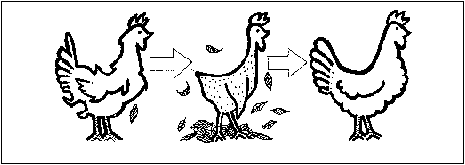



Moulting - a natural process
by M R Ellis, Poultry Branch, Agriculture Western Australia, Reviewed by DPI&F officers - During the autumn, many household poultry keepers, particularly people keeping poultry for the first time, are often puzzled because although their laying birds appear healthy, egg production has markedly declined or ceased altogether.
 Some people just accept this situation and hope for an improvement, while others look upon it as a strange disease. This seasonal decline in egg production occurs when birds go into a condition known as the “moult”.
Some people just accept this situation and hope for an improvement, while others look upon it as a strange disease. This seasonal decline in egg production occurs when birds go into a condition known as the “moult”.
Moulting is the process of shedding and renewing feathers. During the moult the reproductive physiology of the bird is allowed a complete rest from laying and the bird builds up its body reserves of nutrients.
The provision of new feathers or coat (a feature inherent in most animals) is a natural process, designed by nature to maintain the birds' ability to escape enemies by flight and to provide greater protection against cold winter conditions.
Normally, under natural conditions, moulting in adult birds will occur once a year, though it may occur in certain individuals twice in one year, and more rarely only once in a period of two years.
The pullet
The chick goes through one complete and three partial moults during its growth to point of lay, after which the mature bird normally undergoes one complete moult a year, usually in autumn although this depends on the time of the year at which the bird commenced laying. Generally complete moulting occurs from 1-6 weeks and partial moulting at 7-9 weeks, 12-16 weeks and 20-22 weeks, and during this latter moult the stiff tail feathers are grown.
The laying hen
Natural moulting usually begins sometime during March-April and should be completed by July when egg production recommences. The three main factors which bring about moulting are:
- physical exhaustion and fatigue
- completion of the laying cycle. Birds only lay eggs for a certain period of time
- reduction of day length, resulting in reduced feeding time, and consequent loss of bodyweight.
Eleven months continuous production is expected from pullets hatched in season, so that if a flock of pullets commenced laying in March at six months of age, they should continue laying until the following February, although the odd bird may moult after laying for a few weeks. These few birds however should begin laying again after June 22 (the shortest day of the year) and continue in production until the following autumn.
Pullets coming into lay in June should lay until the following April thereby giving eleven months continuous egg production without the aid of artificial light. Pullets coming into lay in spring (August) should lay well into April (9 months) but unless artificial lighting is provided, most of them will moult during May and June.
Moulting and nutrition
Cessation of lay and moulting indicate that the birds' physical condition is deteriorating, and is therefore unable to support egg production, continued nourishment of their feathers and body maintenance. Feathers contain protein and are more easily grown when laying ceases, because of the birds difficulty in assimilating sufficient protein for both egg and feather production. During the moult the fowl still requires a considerable amount of good quality food to replace feathers and build up condition.
Good layers and moulting
The time at which a laying hen ceases production and goes into her moult is a reliable guide as to whether or not she is a good egg producer. Poor producing hens moult early (November-December) and take a long time to complete the process and resume laying i.e. she will hang in the moult and be out of production for a long period - from six to seven months. Poor producers seldom cast more than a few feathers at a time and rarely show bare patches. High producing hens moult late, moult for a short period (no more than 12 weeks) and come back into production very quickly. Rapid moulting is not only seen in the wing feathers of good producers, but also in the loss of body feathers generally. Because of this it is common to see a late and rapid moulting hen practically devoid of feathers and showing many bare patches over her body.
The moulting process
 Moulting takes place in a fairly definite order. Feathers are confined to definite tracts or areas of the body surface, with bare patches of skin between. The first plumage is lost from the head and neck, then from the saddle, breast and abdomen (body), then the wings and then from the tail.
Moulting takes place in a fairly definite order. Feathers are confined to definite tracts or areas of the body surface, with bare patches of skin between. The first plumage is lost from the head and neck, then from the saddle, breast and abdomen (body), then the wings and then from the tail.
While the first feathers are being dropped from the neck and body, good layers will often keep laying, but when the wing feathers begin to drop, laying usually ceases.
The main wing feathers consist of four tiny finger feathers on the extreme tip of the wing, then ten large primary or “flight” feathers, the small axial feather, and the fourteen secondary feathers, which are smaller and softer than the primaries.
When the wing moults, primary feathers are shed first, from the axial outwards to the end of the wing, and then the secondaries, which are not shed in such a set order as the primaries. The axial feather is dropped at the same time as the secondary next to it. The new quill starts to grow as soon as the old feather is out and takes approximately six to seven weeks to grow. The moult is complete when all primary flight feathers on the wing are replaced. The feathers of the moulted bird are large and full, softer, cleaner, brighter and glossy in contrast to the feathers before moulting which were small and hard, dry, frayed and tattered.
Figure 1 (above). The moulting process. Primary feathers are shed first from the axial feather outwards to the end of the wing. Number 1 primary feather is first to drop followed by a number 2 and then in order to number 10. While the primaries are being shed the secondaries begin to drop but not in any set order

Figure 2. Moulting - a natural process
The difference between a rapid and slow moulter is not due to a difference in growth rate of the individual feather, but because the rapid moulter renews a large number of feathers at the same time. With this knowledge, the rate of moulting can be ascertained by examining the number of flight feathers on the wing being replaced simultaneously. If a hen is found to have grown some of her primaries before starting to moult her secondaries, it may be assumed that she laid well into the moult and was therefore a good layer.
Sometimes, high producing hens do not moult all their primary feathers but carry them on for another year. Generally a layer moults when production ceases although if the bird has an inherited tendency for high production, moulting will probably precede cessation of production, and conversely if she is a poor producer. Modern laying breeds should moult in late autumn because they have been bred specifically for egg production i.e. to lay at a higher rate and for a longer period of time.
Vacation moults, neck moults or partial moults
Old feathers are usually retained by a laying bird which lays regularly. Should she cease production for any other reason than for mild sickness or broodiness she will lose her feathers.
If a hen ceases production during spring or summer, she may moult one or two primaries, then stop moulting and come into lay again. This is known as a vacation moult. When she starts her full moult later in the autumn, she will drop the next feather in sequence and moult in order of the remaining primaries. A neck or partial moult is sometimes experienced by a bird without any loss of production, but if the moulting extends beyond the neck moult stage the hen ceases production.
The presence of “pin” feathers (new emerging feathers) usually indicate a short or partial moult.
Some birds moult continuously and can be easily detected in the flock by the spotless condition of their new feathers. These birds are poor producers and should be culled.
Stress factors and moulting
Natural moults can occur any time of the year due to birds being subjected to stress. A bird is stressed when the environment or management present a challenge to which the bird cannot respond without suffering a harmful effect. A hen subjected to a mild stress condition in late spring when in full production will suffer a drop in egg production whereas the same stress condition applied to a bird in the autumn will cause her to cease laying and moult.
The following are common stress factors which can induce moulting:
- Lighting
- decreasing daylight
- decreasing artificial light
- Loss of bodyweight
- Disease
- Internal parasites
- Climate
- excessive cold
- heat waves
- Feed, feeding and feedstuffs
- deficiencies of essential ingredients
- irregular feeding
- insufficient feed
- Predators eg. cats and dogs
- Fright - wild birds and children
- Peck order - low vitality
- Prolonged broodiness
- Mismanagement: overcrowding, movement to another house, water deprivation, insufficient feed and water space, faulty ventilation, wet litter, debeaking, vaccinations, exposed housing, etc.
Force moulting
Force moulting is a practice adopted by some commercial egg producers to bring about a rapid moult so that all the birds come back into lay for a second time at a certain time of the year, usually in autumn. It is achieved by subjecting a flock to a programmed combination of mild environmental stress factors causing the birds to cease laying and consequently moult e.g. decreasing the artificial lighting programme. Force moulting is a practice not normally applicable to the household situation. Natural moulting is slower and more erratic than force moulting.
Production and moulting
After moulting, the second year of egg production will be between 10 and 30% less than that achieved by the birds in their first year of lay. This is because the rate of lay is lower and the birds cease to lay earlier in the following autumn. Birds which have moulted twice and are laying for their third year will lay only 70 to 80% of their second years eggs i.e. about 60% of their first year's production.
Moulting cockerels
Like hens, cockerels also moult, and while in this condition are nearly always infertile due to loss of bodyweight and because their reproductive physiology is undergoing a resting phase. Care must be taken to ensure that cockerels do not lose more than 25% of their bodyweight while moulting as this can lead to sterility.
Advantages and disadvantages
The advantages of keeping hens during the moult and the following year is fourfold:
- it is cheaper to carry a bird through a moult than to buy replacement pullets
- fewer replacement pullets may be needed, and buying can often be deferred, which can mean a saving of money, time and transport
- moulted birds are hardier, and not as prone to disease
- if strict culling is carried out during the first year, only high producing, efficient birds will be retained.
Other disadvantages are:
- during the moult the birds continue to eat but remain unproductive
- if the birds are to be slaughtered for the table after two years of laying they will not be as tender to eat
- too few birds may be retained to provide sufficient eggs the following year.
Year-round laying and moulting
All-year-round egg production can be achieved by purchasing pullets at point-of-lay in the autumn to provide sufficient eggs while the older birds are moulting. When the rate of lay of the pullets declines in the summer, the additional eggs from the moulted birds should sustain an adequate supply. The following autumn the older birds can be killed for the table, the best pullets allowed to moult and another lot of pullets on point-of-lay purchased. In effect therefore, allowing for 20% wastage of pullets due to deaths and culling, only 70% of the normal pullet requirements need to be purchased, and at the same time a relatively constant year round supply of eggs is guaranteed.
Source: Department of Primary Industries and Fisheries - September 2004









